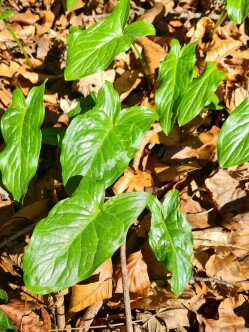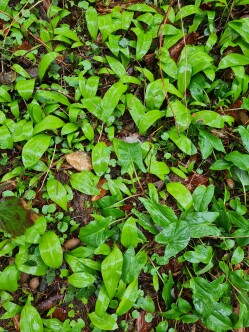Synonyms: wild arum, Arum maculatum. There is an abundance of trivial names for arum
Classification of toxicity: toxic
Tox Info Suisse is only aware of mild cases of poisoning in children. Anyone who accidentally bites into the plant will be in for a nasty surprise – its burning hot taste and tingling in the mouth fortunately prevents the voluntary consumption of larger quantities.
Tox Info Suisse has recorded only a few cases of animal poisoning. Cases of serious, even fatal poisoning are known from the literature, predominantly in grazing livestock.
Arum (Arum maculatum; Araceae family, arum)
All parts of the plant are toxic. They contain needle-like calcium oxalate crystals (referred to as raphides), which are harmful to the skin and mucous membranes and have a strong irritating effect.
Fresh plants and their sap have a stronger effect than dried parts of the plant. In times of adversity, the extremely starchy tubers were used as a food – after cooking for a long time to remove the toxin.
Occurrence: Prefers shady sites (like wild garlic!), deciduous and floodplain woodlands, hedges.
Features: Herbaceous, 15–40 cm tall plant with a tuberous root. Leaves start growing in the spring and are broadly spear- or arrow-shaped with a long stalk, 10–20 cm long, dark green and sometimes spotted. The yellowy green and white bract forms a spathe (an insect trap for pollination) with the flower unfurling in the evening. After flowering, the foliage dies back while the poker-like spadix remains. This holds tightly packed green berries, which turn scarlet red when ripe, are about the size of a pea (ripening in late summer), and taste sweet.
Risk of confusion: Wild garlic leaves (allium ursinum)
Arum grows in the immediate vicinity of wild garlic and the young leaves look very similar. Quickly picking leaves from a carpet of wild garlic without paying close attention could mean a young arum leaf ends up in your harvest.
A comparison of arum and wild garlic leaves
Arum leaves:
Open circular leaf stalks, leaves largely spear- or arrow-shaped and often spotted, glossy top, unremarkable odour.
Wild garlic leaves:
Leaves sprout individually from the soil with a clearly recognisable thin stem (triangular cross-section) that is distinct from the main leaf (stalked), elliptical-shaped leaves, matt underside, characteristic garlic odour.
What should you do in an emergency?
After swallowing:
1) Small parts of the plant (leaves, flower, ≤ 5 berries, see 5-red-berry-rule)
- Do not induce vomiting.
- Remove any plant remains, wash out mouth.
- Drink 100–200 ml of clear, fat-free fluid,
e.g. water, cordial or tea - If available: consume milk, yoghurt or ice cream
Administered for localised cooling and the calcium contained binds the oxalic acid into an insoluble complex that will be excreted.
2) Larger quantities of plant material, > 5 red berries
- Contact Tox Info Suisse.
- Only take activated charcoal following consultation with Tox Info Suisse or a doctor.
After eye contact with sap:
- Remove contact lenses.
- Rinse eyes immediately for 10–15 minutes with clean, lukewarm water; use fingers to hold eyelids open.
- If a child is affected: Have someone help them wash their eyes.
After skin contact:
- Wash the affected skin parts with copious amounts of flowing, clean and lukewarm water.
- Treat as per a mild burn.
Symptoms
After swallowing:
1) Small parts of the plant, ≤ 5 berries
Rapid onset of local irritation of the oral mucous membrane, lips and tongue, in some cases with temporary burning, pain, redness, swelling and salivation. Rarely, blistering in the mouth.
2) Larger quantities of plant material or > 5 berries
Potentially acute gastrointestinal symptoms and severe swelling.
After eye contact with plant parts:
Mild irritant effect.
After skin contact:
Local irritation with redness and burning (similar to burn) leading to blistering.
When should you seek medical attention?
In the case of severe or persistent symptoms.
Prevention
- Beware of toxic wild garlic lookalikes
If you pick wild garlic, make sure you are familiar with its distinguishing features so you can avoid toxic doppelgängers. More on this topic in the Tox blog post: Do you know the toxic doppelgängers of wild garlic?. In comparison to wild garlic, arum does not taste like garlic. However, if you put a leaf in your mouth to try, the pain will be a nasty surprise. - Protect your skin
Wear gardening gloves when cutting the plant or clearing from the garden. - Protect your children
Explain to your children as early as possible that some plants are toxic and they should never put leaves or berries in their mouth without asking an adult.
Further information
Related species as popular houseplants:
Several members of the arum family (Araceae) are popular houseplants: For example, calla (Zantedeschia aethiopica), Dieffenbachia (Dieffenbachia), Devil’s ivy (Epipremnun areum), peace lily (Spathiphyllum), Monstera (Monstera), flamingo flower (Anthurium), and Zanzibar gem (Zamioculcas zamiifolia).
Like arum, these plants have calcium oxalate raphides and often cause similarly painful symptoms as described for arum for the young children who accidentally sample them.
Other articles from Tox Info Suisse:
Do you know the toxic doppelgängers of wild garlic?
Red berries, black berries, When is it ok to nibble and when is it dangerous?
Latest specialist literature
February 2024






